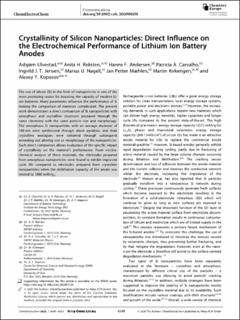| dc.contributor.author | Ulvestad, Asbjørn | |
| dc.contributor.author | Reksten, Anita | |
| dc.contributor.author | Andersen, Hanne Flåten | |
| dc.contributor.author | Almeida Carvalho, Patricia | |
| dc.contributor.author | Jensen, Ingvild Julie Thue | |
| dc.contributor.author | Nagell, Marius Uv | |
| dc.contributor.author | Mæhlen, Jan Petter | |
| dc.contributor.author | Kirkengen, Martin | |
| dc.contributor.author | Koposov, Alexey | |
| dc.date.accessioned | 2021-04-07T12:42:21Z | |
| dc.date.available | 2021-04-07T12:42:21Z | |
| dc.date.created | 2020-11-03T08:36:49Z | |
| dc.date.issued | 2020 | |
| dc.identifier.citation | ChemElectroChem. 2020, 7 (21), 4349-4253. | en_US |
| dc.identifier.issn | 2196-0216 | |
| dc.identifier.uri | https://hdl.handle.net/11250/2736655 | |
| dc.description.abstract | The use of silicon (Si) in the form of nanoparticles is one of the most promising routes for boosting the capacity of modern Li‐ion batteries. Many parameters influence the performance of Si making the comparison of materials complicated. The present work demonstrates a direct comparison of Si nanoparticles with amorphous and crystalline structures prepared through the same chemistry with the same particle size and morphology. The amorphous Si nanoparticles with an average diameter of 100 nm were synthesized through silane pyrolysis, and their crystalline analogues were obtained through subsequent annealing not altering size or morphology of the nanoparticles. Such direct comparison allows evaluation of the specific impact of crystallinity on the material's performance. From electrochemical analysis of these materials, the electrodes prepared from amorphous nanoparticles were found to exhibit improved cycle life compared to electrodes prepared from crystalline nanoparticles when the delithiation capacity of the anode was limited to 1000 mAh/gSi. | en_US |
| dc.language.iso | eng | en_US |
| dc.publisher | Wiley | en_US |
| dc.rights | Navngivelse 4.0 Internasjonal | * |
| dc.rights.uri | http://creativecommons.org/licenses/by/4.0/deed.no | * |
| dc.subject | Nanoparticles | en_US |
| dc.subject | Batteries | en_US |
| dc.subject | crystalline structures | en_US |
| dc.title | Crystallinity of silicon nanoparticles: Direct influence on the electrochemical performance of lithium ion battery anodes | en_US |
| dc.type | Peer reviewed | en_US |
| dc.type | Journal article | en_US |
| dc.description.version | publishedVersion | en_US |
| dc.rights.holder | © 2020 The Authors.ChemElectroChem published by Wiley-VCH GmbH. | en_US |
| dc.source.pagenumber | 4349-4253 | en_US |
| dc.source.volume | 7 | en_US |
| dc.source.journal | ChemElectroChem | en_US |
| dc.source.issue | 21 | en_US |
| dc.identifier.doi | 10.1002/celc.202001108 | |
| dc.identifier.cristin | 1844351 | |
| dc.relation.project | Norges forskningsråd: 243802 | en_US |
| dc.relation.project | Norges forskningsråd: 197405 | en_US |
| dc.relation.project | Norges forskningsråd: 280985 | en_US |
| dc.relation.project | Norges forskningsråd: 257653 | en_US |
| cristin.ispublished | true | |
| cristin.fulltext | original | |
| cristin.fulltext | original | |
| cristin.qualitycode | 1 | |

